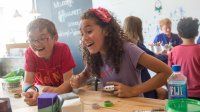CSI Verona: Science and Literature Combine
Bringing together Shakespeare and forensics, or Icarus and design thinking, shows how literature and science can illuminate each other.
Your content has been saved!
Go to My Saved Content.The best innovation often occurs through collaboration between people in completely different subjects. Interdisciplinary collaboration in education allows teachers to move beyond their routine lesson plans to develop curricula from fresh perspectives. Using science to bring classic literature to life, for example, allows students to see, feel, touch, and experience the subjects.
The Forensics of Macbeth’s Crime Scene
Forensics study involves discussion of real cases and real crimes. We devised a collaboration to connect forensic science to classic literature by teaching crime scenes through Shakespeare’s Macbeth.
We re-created a crime scene based on the murder of King Duncan by Macbeth. Lady Macbeth is constantly washing and rubbing her hands. Students examined some of Lady Macbeth’s lines: “Out, damned spot” and “What, will these hands ne’er be clean?” We asked, is it all psychological, or to what degree can our hands be stained with blood?
The students conducted a presumptive blood test with a fake blood mixture. Using luminol, a substance that reacts with hemoglobin in blood, students saw how traces of blood remained on their hands even after they were washed.
Students learned physics through the study of blood spatters. They determined the height of the spatters based on how they fell and the velocity based on their shapes. If there was a trail of blood on the ground, it indicated that the perpetrator was running or walking, based on the drips on the floor. If blood was found on the walls, students determined the dominant hand by assessing whether the slashing motion was left to right or right to left.
The students used trigonometry to analyze the crime scene to see at what angle the blood hit the ground. We gave them characteristics of characters in the castle to see how their traits (left-handed, walked with a limp) matched the way the crime was committed.
Although the activities were science-focused, students also answered broader questions about the relationship between the play and science. How deep are human ambition and the quest for power? If Macbeth and Lady Macbeth had known about later advances in forensic science, would they still have committed the crimes?
We tied the analysis to modern-day challenges, asking, “Do you believe that advances in forensic science stop people from committing crimes? Or is the pull of emotions in human nature so great that crimes will be committed regardless of the threat of being caught?”
Crime Scene Investigation Verona
After reading Romeo and Juliet, we conducted a “CSI Verona” investigation to determine whether the deaths of Romeo and Juliet could have been prevented.
Students received a letter telling them that they were part of a new crime scene unit to investigate the suspicious deaths of two teenagers. They also received an evidence file that outlined the stories and quotes of the accused. Photos represented mug shots of the different characters: Lord and Lady Capulet, Lord and Lady Montague, Tybalt, Mercutio, and Friar Lawrence.
Students were divided into “Crime Scene Unit” teams. Each team investigated one character. They identified at least six quotes to determine how the actions or words of the characters made them guilty of driving Romeo and Juliet to their deaths. Each group presented their findings and evidence to the class, using the quotes to explain why their character was guilty or not guilty.
At the end, each student decided which character was most guilty. They wrote a formal five-paragraph paper explaining how if this person had acted differently, Romeo and Juliet would have lived.
Next, students considered the play from the perspective of Romeo, who discovered Juliet with a vial next to her. Students conducted a chemistry analysis to determine whether a sample from Juliet’s vial matched substances representing the possible poisons she could have taken. They examined each powder under the stereomicroscope in a watch glass noting color, texture, and other observations in a data table. They conducted a drug spot assay to observe and compare the substances, and they recorded their observations to determine what was in Juliet’s vial.
Design Thinking and Engineering in Greek Mythology
The myth of Icarus provided a foundation for introducing design thinking and engineering. After reading the story, students identified the problem: creating a flying mechanism to escape the tower that could withstand heat from the sun and water from the sea.
Students worked in small groups and spent time brainstorming and drawing prototypes of what they thought would work. I brought in many different kinds of simple materials, like string, coffee filters, aluminum foil, yarn, card stock, tissue paper, clay, feathers, dry spaghetti, and duct tape. Students worked in small groups to brainstorm and create any type of vehicle that could soar from a height. They tested the devices they created under a blow dryer to expose them to heat, as well as in a tub of water. The students tested the devices’ soaring capacity again, and they had the chance to review and revise.
Creating interdisciplinary lessons by collaborating with other educators can be a powerful tool for engaging students and deepening understanding. Students invest in the experiments because they are part of a larger narrative. Students who think they are not “science people” are able to gain an entry point to scientific discovery. Others who do self-describe as science people are able to think more creatively about their work. Combining science and literature increased comprehension of complicated texts for all students by making the activities part of a bigger story line.
